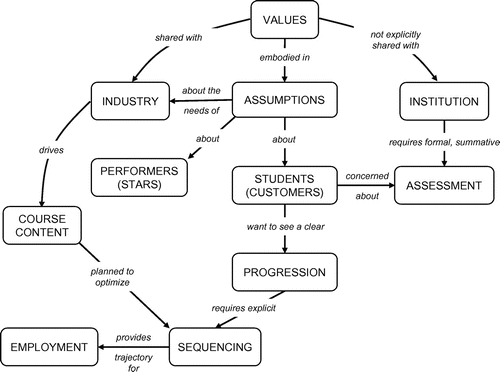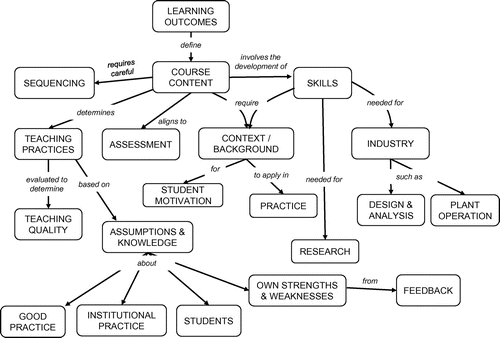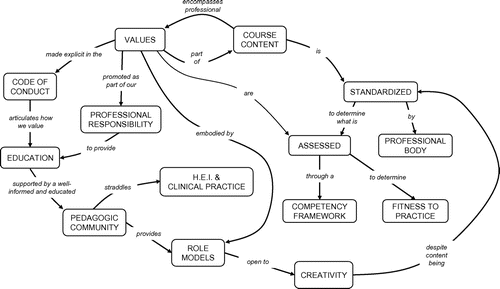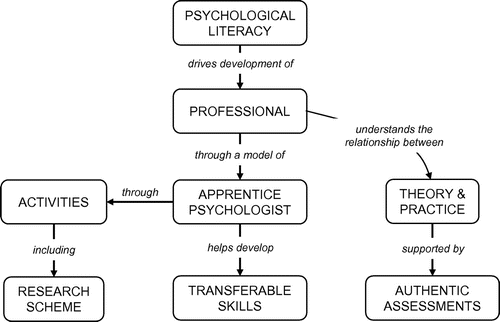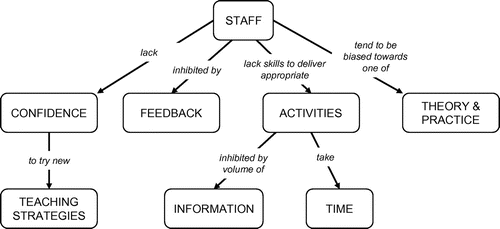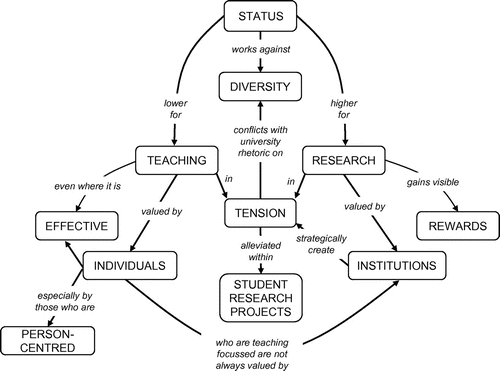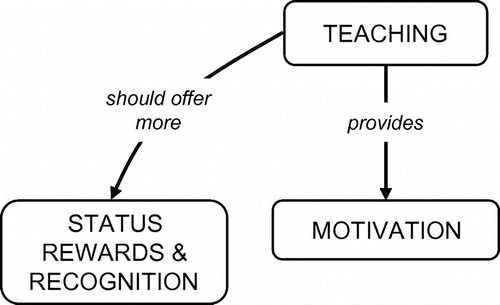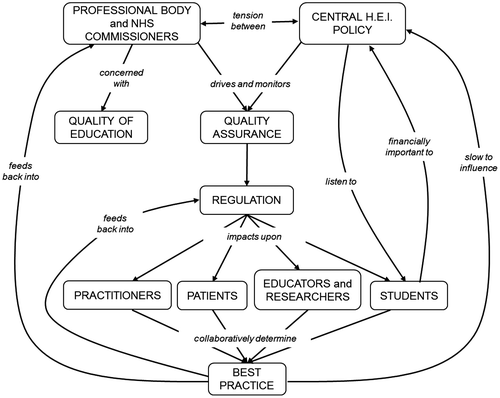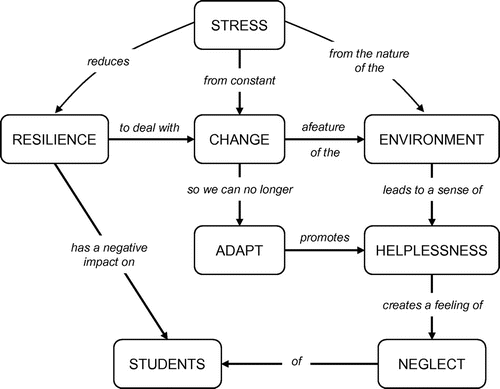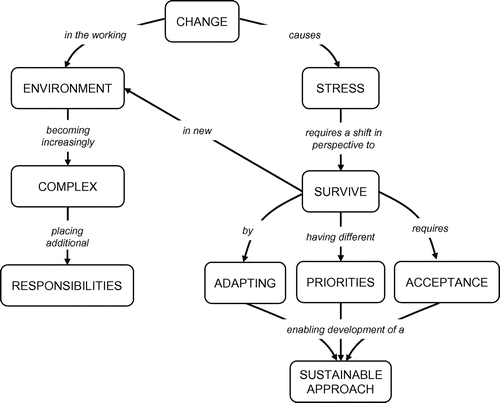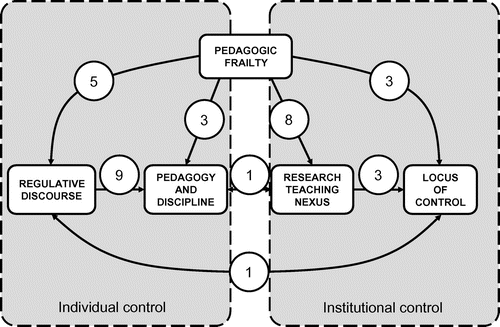Abstract
Background: The concept of pedagogic frailty has been proposed as a unifying concept that may help to integrate institutional efforts to enhance teaching improvement within universities by helping to maintain a simultaneous focus on four key areas that are thought to impede development. Purpose: The variation in internal structure of the four dimensions of pedagogic frailty and the links that have been proposed to connect them are explored here through the analysis of interviews with academics working in a variety of disciplinary areas. Methods: The application of concept map-mediated interviews allows us to view the variable connections within and between these dimensions and the personal ways they are conceptualised by academics working across the heterogeneous university context. Results: The data show that academics conceptualise the discourse of teaching in various ways that have implications for the links that may be developed to integrate the elements within the model. Conclusions: Whilst the form and content of the maps representing dimensions of the pedagogic frailty model exhibit considerable variation, it is suggested that factors such as academic resilience and the explicit use of integrative concepts within disciplines may help to overcome some of the vulnerabilities that accompany pedagogic frailty. The data also raises questions about the links between factors that tend to be under individual control and those that tend towards institutional control.
Introduction
Universities expend considerable time and energy to enhance the quality of teaching received by their students and to gain recognition of their teaching quality (e.g. in league tables), and to perform well in student satisfaction ratings. However, there appears to be no unifying concept that might help to integrate these efforts and increase their effectiveness in enhancing the quality of student learning. Indeed, within this environment, some commentators in the USA consider the learning gains achieved by undergraduates to be so poor that they describe large numbers of students as being ‘academically adrift’ (Arum and Roksa Citation2011). The piecemeal consideration of teaching elements across the international research literature, such as classroom practice, assessment techniques, technology-enhanced learning and feedback (for example) fails to bring these components into simultaneous focus with the result that teaching development becomes a juggling act with little chance of keeping all the balls in the air. In an attempt to provide a fresh perspective on teaching development and to prompt reflections on ‘what else they might do’ (Gibbs Citation2013, 13), this paper interrogates the emerging concept of pedagogic frailty (Kinchin Citation2015, Citation2016) as an integrative term to articulate a complex situation. Factors that contribute to pedagogic frailty are considered as well as possible outcomes of the condition. The aetiology of frailty is traced here through map-mediated interviews with academics. This recognition will eventually enable a consideration of potential strategies to avoid frailty and so create the possibility to enhance the university teaching environment in a more integrated and coordinated manner.
There are concepts from other disciplines that can sometimes be helpful in making useful analogies in educational research. This often draws on established ideas from the sciences which provide anchoring concepts against which comparison can be made. Indeed, Glynn (Citation1991) proposed a ‘teaching with analogies model’ to exploit this idea and to support the acquisition of difficult concepts. In higher education, such analogies have included the consideration of DNA as providing a stable base from which change may (or may not) arise (Christensen Citation2011), whilst the adoption of ecological analogies has been widely used to express the complexity of the environment in which educational processes must continue (e.g. Toulmin Citation1972; Strike and Posner Citation1992; Doyle Citation2006; Stelma Citation2011).
Within the clinical literature, ‘frailty’ is considered to develop as a consequence of a decline in a range of factors which collectively results in an increased vulnerability to sudden adverse actions triggered by relatively minor events (Clegg and Young Citation2011). Various indicators of frailty have been identified and include the inability to integrate responses to change in the face of stress (Rockwood et al. Citation1994); the loss of adaptive capacity due to a loss of complexity (Lipsitz Citation2002); the wear and tear that results over time by repeated efforts to adapt to change (Seeman et al. Citation2002); the sense of fatigue when change is implemented without consultation (MacIntosh et al. Citation2010). These issues would appear to offer considerable resonance with the pressures felt by academics teaching at university. In the context of higher education teaching, one might observe pedagogic frailty (Kinchin Citation2016) when colleagues find the cumulative pressures of academia eventually inhibiting their capacity to change practice in response to an evolving teaching environment, leading them to adopt what they might consider a ‘safe’ and sustainable pedagogic approach (Canning Citation2007). Pedagogic frailty may contribute to recently observed occurrences of the arrested professional development of university teachers, in which they have been described as experienced non-experts (Brody and Hadar Citation2015; Van Waes et al. Citation2015). Moreover, such an outcome may in fact be against the typical aspirations of the teaching researcher, whereby motives for professional and personal development are in dissonance with the cultural normalisation towards safe teaching.
Frailty is not considered here as an internal quality or capacity of an individual academic per se, and indeed such a personal characterisation may be unhelpful in promoting openness to support academic faculty development. Rather we see frailty as resulting from the quality and degree of interaction with and between key elements of the professional environment, analogous to the ‘ecological perspective’ that Priestley, Biesta, and Robinson (Citation2015, 3) have adopted in their recent interpretation of teacher agency, who consider ‘the cultures, structures and relationships that shape particular “ecologies” within which teachers work’. However, frailty may also be considered at different levels of resolution when considering these connections, from the individual to the departmental or the institutional.
Conservatism in teaching approaches (e.g. Bailey Citation2014) can lead to a convergence on traditional views of teaching in which the transmission of content is seen to dominate and teaching is structured as a procedural chain of practice (Kinchin Citation2009). This does not leave room for innovation and as stated by Douglas (Citation2014, 81), ‘staying in the safe harbour of monolithic lecturing will most likely result in many missed learning opportunities’. Such a situation may be most pronounced in institutions of long and revered reputation, whereby much value is given to established practice and tradition to the extent that ‘universities hang on to past practices to the point of imperilling their futures’ (Christensen Citation2011, xxii), with the cultural inclination towards change being stronger in relatively young (rather than established) institutions. In their report on the stratification of pedagogy across the UK universities, Stevenson, Burke, and Whelan (Citation2014, 39) conclude that the overall picture is a complex one, ‘with institutions striving to distinguish themselves as distinct whilst at times, homogenising their approaches to teaching excellence, pedagogic practices and the overall student experience’.
Teaching conceptualised as a linear chain of activity is indicative of strategic success (i.e. ‘it works for me’) in which the academic selects what is considered the essential information to convey his/her view of teaching and selectively ignores the rest (Kinchin Citation2009). The competence that is indicated by such chains has been described as a ‘monolayer of understanding’ by Talbot (Citation2004), in which dialogue plays no part in subsequent development; i.e. it portrays an authoritarian certainty that has only a single possible route from beginning to end. This makes the evolution of teaching practice more problematic (Kinchin Citation2011), and hence increasingly frail. In addition, the adoption of innovative technologies (such as virtual learning environments) into such a restrictive model means that any transformative potential is corrupted to perform utilitarian tasks, maintaining the status quo of non-learning (Kinchin Citation2012). Within such an environment, it is not difficult to see why colleagues may find the idea of the ‘scholarship of teaching’ to feel like an unhelpful distraction from their daily tasks (e.g. Boshier Citation2009).
One of the underlying causes of pedagogic frailty may be the way in which discourses surrounding the instructional mechanisms of teaching seem to take precedence over the discourse of the underpinning values. Bernstein (Citation2000) refers to curriculum in terms of its regulative discourse (RD), and instructional discourse (ID). The RD refers to the values that underpin the curriculum. ID refers to content selection, sequencing, pacing and assessment. Bernstein argues that the ID is always embedded in the RD, whether the RD is explicit or implicit. Observations of programmes and their supporting literature often suggest that departments typically focus on the ID without paying much attention to the RD (Kinchin et al. Citation2015). Meetings are set-up to discuss content to be taught and assessments to be created, but little time seems to be spent on discussing the underlying philosophy, values or pedagogy that support the programme. These less tangible factors seem to be assumed to be a ‘given’. Even if they have been acknowledged within the original validation documentation of the programme when it was established, how the RD is evaluated as it evolves or takes into account induction of new members of teaching staff or insertion of new technology into the teaching mix is rarely noted.
New academics who may have their horizons broadened through introduction to a variety of research into teaching and learning through HEA-accredited programmes of faculty development (e.g. Kandlbinder and Peseta Citation2009) may succumb to the conventional wisdom of the dominant group so that their emerging dynamic and progressive teaching frameworks are eroded by the stresses of the job and the indifference (or active negativity) of jaded senior colleagues towards the discourse of teaching and learning. This allows academics to settle into a comfortable cycle of non-learning (Kinchin, Lygo-Baker, and Hay Citation2008), with the aim of releasing more time to focus on research activities that are perceived to be of higher status (Young Citation2006; Cretchley et al. Citation2014). Indeed, relatively little value may be gained from the usual academic performance indicators of funding, publication or international accolade when associated with an educational (teaching and learning) endeavour (Alpay and Verschoor Citation2014). This leaves the institution in a state of pedagogic frailty. Such frailty results in institutions having a limited repertoire of responses to demands of the teaching and learning environment. This is illustrated by the apparent impotence of universities to address students’ on-going dissatisfaction with assessment feedback practices (e.g. Evans Citation2013), exacerbated by a lack of agentic engagement on the part of the students (e.g. Reeve Citation2013), to which institutional responses are typically ‘just do more and do it faster’, as if increasing the dosage of an inappropriate medicine will eventually become a cure. This is an example of the loss of adaptive capacity due to a loss of complexity described by Lipsitz (Citation2002).
Based on informal discussions with large numbers of academics, and on dialogues within academic development programmes, a tentative model of the relationships between the dimensions of pedagogic frailty has been proposed by Kinchin (Citation2015, Citation2016) (Figure ). Segments of this model represent factors that are continually under scrutiny within the international research literature and within the dialogues between participants on academic development programmes. They were recently amplified during the development of an MA programme in higher education (Kinchin et al. Citation2015).
Figure 1. A tentative model of pedagogic frailty, indicating relationships between the four major dimensions (from Kinchin Citation2015, Citation2016).
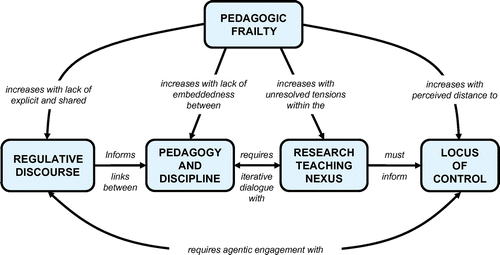
Methods
After initial exploratory discussions with each of the colleagues who the lead author thought would have an interest in developing the idea of pedagogical frailty, they agreed to be interviewed for this study and share their perspectives on the resulting maps as co-authors of the resulting paper, and so relinquish their anonymity from the data.
In order to interrogate the model and determine the range of possible internal structures of each of these dimensions, data presented here are drawn from five map-mediated interviews with academics to explore indicators of stressors that may accumulate in such a way that relatively small events (changes in the academic environment) may become impossible to accommodate within the perceived straitjacket of traditional teaching models. These dimensions in which the indicators are grouped include the tension between teaching and research that exists within an asymmetrical context in which rewards are not perceived as equal in status; the perceived separation of pedagogy and discipline; the centralisation of administration that removes control of processes from the end-users; and the lack of a shared and explicit RD within teaching and learning strategies. The first step in combating pedagogic frailty is to identify relationships between the factors that are thought to contribute to the condition.
Concept map-mediated interviews
The method we have adopted in this research project is the concept map-mediated interview (as detailed by Kandiko Howson and Kinchin Citation2014). The standard interview set-up requires the interviewer to present questions to the interviewee in order to gain access to the interviewee’s individual insights and personal perspective. This is achieved by engaging in dialogue (verbal or textual) that is by its very nature linear in structure. Within that linear narrative, it is then up to the researcher-interviewer to determine the underlying conceptual structure within that dialogue to construct an interpretation of the interviewee’s understanding. In essence, the interviewer has to interrogate the interviewee’s invisible knowledge structure (Hay, Kinchin, and Lygo-Baker Citation2008).
Compared with the standard interview, the dynamics within the concept map-mediated interview are changed in a subtle, but important way. Here, the interviewee exposes his/her knowledge structure during the interview through the concept map that emerges within the dialogue between the interviewer and interviewee. Concept mapping (Novak Citation2010) has been shown in previous studies to be the ideal tool to make learning visible and externalise the relationship between public and personal learning in higher education (Hay, Kinchin, and Lygo-Baker Citation2008; Kandiko, Hay, and Weller Citation2013). The interviewer’s job is then to prompt the interviewee with questions that will encourage him/her to interrogate his/her own knowledge structure as it develops on the page. This means that the interviewer no longer has to impose a structure on the linear narrative, but rather interpret the structure that has emerged from the dialogue (Kinchin, Streatfield, and Hay Citation2010). Whilst this process makes it less likely that the interviewer will impose an inappropriate knowledge structure based on his/her prior conceptions, the dialogue between the interviewer and interviewee does help to ensure that the structural grammar of the resulting maps is similar and negates the need for any topographical normalisation (sensu Buhmann and Kingsbury Citation2015) that is often required to facilitate comparison of maps when novice mappers interpret the concept mapping method in idiosyncratic ways.
The resulting concept map is the main artefact for analysis that is created during the interview dialogue. Whilst no restrictions were verbalised to the mapper in terms of the number of concepts to be included, the process used 38 × 50 mm self-stick notelets to act as the nodes on which the concept labels were written, and these were affixed to a sheet of A3 paper, so that once the sheet was becoming full, the interviewees tended to stop adding new ideas. This provided a helpful mechanism to regulate the size of the resulting maps, which in turn helps the interviewee to concentrate on the key ideas they want to present in the available space. The ability to be concise within a concept map is regarded as one of the criteria for excellence (Caňas, Novak, and Reiska Citation2015). The interviewer is also able to prompt the interviewee and ensure that linking arrows are labelled to provide meaning and maximise the explanatory power of the map. This is an aspect of mapping that novice mappers usually find the most challenging. Once the interviewee was happy that the resulting map gave a fair representation of their perspective, it was digitised by the interviewer and returned to the interviewee who was invited to make any amendments they wanted to and to offer any reflective comments on the structure or content of their map. Archer (Citation2008, 400) has commented on how ‘writing about academia is inherently challenging, particularly for those “on the inside”’, and for some of the interviewees, the construction of certain parts of their concept maps proved to be an emotional experience. Such personal reflections, whether looking across an individual’s entire career (Douglas Citation2014), or focussing on a single day (Winkler Citation2013) can reveal important insights to academics’ perceptions of the development of their academic identities within a changing higher education landscape (Hernández et al. Citation2010).
The five interviewees here are all academic staff who have major teaching roles within their faculties. Whilst they are each able to offer their personal perspectives from within their disciplinary areas, they are not ‘representing’ their disciplines in the sense of providing generalizability across domains. However, they do provide insight to the variety of interpretations that may be encountered across a university campus through experiences that are ‘more richly complex at the level of the individual’ that allows us to ‘theorise some of the possible ways in which the life-world of academics is being experienced’ (Clegg Citation2008, 332). Or as Haggis has stated:
it might be fruitful to try to understand something about the ways in which the specifics of context and history translate, in dynamic and unstable ways, into multiplicity and difference in the lives of situated individuals. (Haggis Citation2004, 337).
In order to initiate the interview dialogue, a number of prompting concepts were offered as words on post-it notes for each of the five dimensions (Table ). These were presented in no particular order and the interviewee was told that s/he could use as many or as few of these as they wished, and could add any concepts they wanted to.
Table 1. Prompting concept labels for interviews.
Whilst helpful in initiating the dialogue, the interviewer was careful not to lead the interviewees in the use of these prompting concept labels. They could be included or excluded from the maps. Where they were included, what was important was the way in which they related to other concepts (e.g. ‘xxx is crucial to …’ or ‘xxx is irrelevant to …’) and whether they were central or peripheral to the map, highly connected or loosely connected, and the overall structure to which they contributed.
Analysis of the maps: intra-dimensional analysis
Interviewees were asked to map the elements making up each of the dimensions of the model. The internal structure and content of each of these indicated the components that the interviewee considered to be most significant, along with the links that joined them together. Examples from each dimension are offered below for discussion.
Regulative vs. instructional discourse
Where RD (Bernstein Citation2000) is seen to dominate disciplinary discussion, one would expect to see concepts such as ‘values’ appearing towards the top of the concept map (Figure ). Where the ID is more evident, through discussions of course content, assessment and so on, one would expect these concepts to appear towards the top of the concept map (Figure ). In practice, these two discourses are intertwined and so elements of each will be found to interact.
The key position of values in Figure signifies the evolution of performing arts education within universities. What are now generally referred to as ‘conservatoires’ were originally the drama schools founded in the late nineteenth century, independent private colleges set-up to provide actor training. These institutions, outside the traditional university system, established their own practices and traditions based on the practices and values of the theatre. This became an implicit RD, rooted in the values of the theatrical world – respect, collaboration, hard work and never missing a deadline (Cohen Citation2011). In the theatre, everyone is essentially working towards the same simple goal – to get the show produced on time. Hence, great emphasis is placed in the drama school curriculum on punctuality, effective teamwork, etiquette and professional behaviour as these are essential in achieving that goal.
Another key aspect of the implicit RD is the idea that the drama school is an integrated part of the theatre business. In practice this means that desirable teachers are those who are actively engaged in professional practice as actors, designers, directors and technicians, in order to remain connected and current. It also means that hierarchies within the drama school, both amongst staff and students, mimic those of the professional world – effectively a feudal system where the director is ‘God’, other members of the creative team are his inner circle of disciples, the actors must be managed and the stage management and technicians make the whole thing work. Again this is implicit rather than explicit.
The overall RD within professional drama education prioritises the passing on of values by ‘joining the world of the theatre’; as Drama UK state in the Citation2014 Guide to Professional Training, ‘accredited schools … offer a direct route into the profession’. Within that, content is planned and sequenced to meet the needs of three stakeholders – the student, who has bought a specific ‘package’, the industry, which expects graduates with specific skills and abilities, and the institution, which sets the rules, parameters and institutional aims. Although the student should be a priority when designing learning and teaching, in practice the institutional structures come first (timetabling, assessment deadlines, budgets), followed by the needs of the industry (for example, performers with ‘triple-threat’ skills, imaginative and resourceful technicians), and finally the needs of the students (a positive learning experience in a supportive environment).
Interestingly, ‘educational theory’ was actively discounted as a concept to include in their maps by all the interviewees. This was not because they thought it lacked importance, but because they did not consider it to be a significant part of their disciplinary discourse on teaching and learning. This disjuncture between educational research and theory production on one hand, and educational practice on the other hand has been noted in the literature and reviewed by Kezar (Citation2000). In addition, Tight (Citation2004) has commented that ‘higher education researchers, for the most part, do not appear to feel the need to make their theoretical perspectives explicit’. In which case, it seems likely that their implicit perspectives will not be evident to those looking in from other communities of practice within the university. This suggests that when universities describe their teaching as ‘research-led’ or ‘research-informed’ this does not, in practice, refer to pedagogic research informing teaching practice as part of the RD, but rather it refers to disciplinary research informing content selection as part of the ID. However, it is difficult to verify which of these interpretations is intended within university documentation that typically lacks explicit definitions of the terms used. This has been summarised by Cleary (Citation2013, 19), who states that universities tend to be ‘self-proclaimed research-led teaching centres, with no real way of evaluating the veracity of the claim, or even what the claim means’.
Whilst there have been significant efforts in Engineering Education to raise the prominence of professional ethics, ‘aspirational approaches to engineering’ (Bowen Citation2009) and authentic and values-driven leadership, concepts of ethics and values largely remain a tangential and, at best, an implicit aspect of discourse that is embedded within the curriculum. Indeed, often so embedded that it is not even recognised as a learning outcome or effectively verbalised by the students and many academic staff, (see also the discussions of Alpay Citation2013). It is therefore not surprising that RD relating to values may be an uncomfortable, perhaps trivialised, but certainly relatively weakly considered aspect of curriculum design and development.
In the perspective offered from health care education, the RD and the ID components appear more integrated (Figure ). Here, ‘values’ for education practice as well as for clinical practice are seen as part of ‘course content’ and so the separation of the regulative and ID is not evident. This is possibly due to the development and ‘delivery’ of health professional curricula being ‘shared’ between HEI and clinical practice (the UK National Health Service). In nursing, for example, the nursing and midwifery council (NMC) require that half of student learning is theory-based and half takes place within clinical placements (NMC Citation2011). Values for education and for professional practice are explicit; such as the importance of organisations valuing learners and their educators. The NMC (Citation2008) also state values to promote equal opportunity in learning and assessment; explicitly requiring individual students are treated with fairness, respect and understanding, irrespective of race, gender and disability. There are also value expectations on educators in terms of creating environments that support effective learning and encourage assessment accountability (NMC Citation2008). Because values are promoted prominently within these explicit standards for education, there is overt integration of the regulative and ID within this context.
Pedagogy/discipline
The diversity of perceptions within this dimension is illustrated by the maps offered in Figures and . Within Figure , the map author is able to provide an integrating concept, ‘psychological literacy’ (PL), which has enabled the two aspects (discipline and pedagogy) to be considered together. Whilst the term ‘psychological literacy’ is not itself new, having been first utilised in an educational context in the 1990s (Boneau Citation1990), in recent years, PL has been framed as the underlying and organising framework for psychology education (Mair, Taylor, and Hulme Citation2013). To a certain extent, this focus recognises the responsibility of psychology educators to ensure that we do not merely fill students with psychological knowledge, but also equip them with the sensitivity to apply this knowledge in ways that are appropriate and fit for purpose, within the boundaries of professional responsibility. Thus, common definitions of PL focus on the application of psychological knowledge, rather than the knowledge itself, focusing on the application of ‘psychological principles to personal, social and organisational issues in work, relationships and the broader community’ (McGovern et al. Citation2010, 10). As a result, pedagogy is linked to discipline in that all aspects of pedagogy are focused on what graduates will do with what they learn at University. This feeds into all aspects of professional training in psychology education, and underpins the focus on treating students as ‘apprentice psychologists’ from day one of the degree, such that they are concurrently developing knowledge, skills, values and attributes that will underpin their application of psychology upon graduation. Students also see the importance of PL and the associated graduate attributes (Morris et al. Citation2013).
It is important to note that such application of psychological knowledge is not restricted to work as a professional psychologist. Psychology students undertake a wide variety of graduate work and the whole concept of PL trades on the belief that the skills and attributes of psychology graduates are so wide-ranging that ‘just about every job suitable for a general graduate will be done better by a psychology graduate’ (Florance, Miell, and Van Laar Citation2011, 699). PL is not, therefore, driven by the desire to produce a ‘psychologist’ in a professional sense, but an individual functioning as a psychologist in the ways in which they carry out their work: ‘Because Psychology is concerned with understanding human cognition, emotions and behaviour, Psychology graduates are equipped with a deep understanding of themselves and others and, given an appropriately focused curriculum, they can acquire a broad range of attributes and competences to apply this knowledge in any endeavour in which humans are involved’ (Mair, Taylor, and Hulme Citation2013, 13).
If we are to develop not only skills but also the ability to apply those skills alongside disciplinary knowledge, students need opportunities to practice linking theory to practice (Mair, Taylor, and Hulme Citation2013). This entails activities that enable students to ‘test drive’ professional roles (e.g. through the Voluntary Research Apprentice Scheme), but also through assessment itself. This underlies many endeavours to provide ‘authentic’ assessments that do not merely serve to measure students’ understanding and ability, but to bring about some new development in their PL as a result of undertaking the assessment (e.g. case study; case formulation). This echoes the commonly stated purpose of authentic assessment, where such assessments should support transfer of knowledge learnt in one area, should be challenging, and should promote metacognition. As an integral component of the education process, assessment supports learning by providing learners with the opportunity to demonstrate acquired skills and knowledge, whilst determining their professional, vocational and academic achievement (Ashford-Rowe, Herrington, and Brown Citation2014). Whilst the benefits of this approach are clear, this endeavour requires a significant degree of effort, risk, and creativity. Many institutions do celebrate and reward innovations in teaching and assessment, but academics must first feel that the likelihood and value of such positive outcomes outweigh risks and potential negative outcomes. According to the expected utility theory of human decision-making, a lecturer deciding whether to innovate would base their decision on the expected outcome, and the likelihood of getting this outcome. Thus, if the chances of getting the desired outcome are too low, the risk of taking the decision is too great and alternative options (in this case, ‘playing it safe’) will be taken. A reluctance to take risks and experiment in teaching is a serious issue because it is only thorough the willingness to experiment with creative techniques that many common problems with learning environments can be overcome (e.g. Winstone and Millward Citation2012), and the scholarship of learning and teaching advanced. If such experimentation is perceived to bear too much risk then it must be the case that lecturers who innovate do so as a result of some personal motivation or incentive rather than the hope of institutional approval or reward.
In contrast to Figure , the author of the map in Figure has taken a very different perspective on the tensions between discipline and pedagogy, where integration is not recognised at all. Indeed, the map recognises that many teachers may be lacking in the necessary skills or confidence to be trying strategies that link theory and practice within their teaching: with teachers occupying one or other side of this divide. We can see, therefore, that individual perceptions can reflect very different environments for individual teachers that will have knock-on effects for other dimensions within the pedagogic frailty framework.
Research-teaching nexus
With reference to Figures and , a clear contrast exists between the authors’ views on the research-teaching nexus within their respective disciplines. For Engineering, the tensions are clear, with a suggested need for concerted consolidation of personal and institutional drivers, as well as a genuine appreciation of diversity in the work place. Engineering education is implicitly linked to the support of industrial development and enterprise, and ultimately to economic output. It is therefore not surprising that the educational institution mirrors the competitive and output (product)-driven culture of industry, and more directly succumbs to the pressures to satisfy the funding opportunities offered by industry. To some extent, this is similar to the situation that has emerged in Medical Education, whereby funding from the pharmaceutical industry has also inadvertently led to tensions in the status of the ‘pedagogic’ community (see Figure ), and on occasion to conflicts of interest (Spithoff Citation2014). Both these contexts reflect the dominant discourse of the sector in which research is given prominence over teaching (Cretchley et al. Citation2014).
In contrast to the map in Figure , the brevity of the map in Figure makes a strong statement about what is and is not important to the map’s author. Whilst discussing the elements of this map the author spontaneously quoted playwright David Hare:
In society today to one side lies academia with all its potential for aridity and pretentiousness, and to the other side what’s called the media with all its potential for stupidity. Down the middle of the road drives the British theatre, where people, through a mixture of high-mindedness and auto-didacticism, present something which is both sensible and idealistic. (Hare cited in Eyre Citation2009, 191)
The succinct perspective summarised in Figure can be elaborated by tracing the changes in performing arts education in recent years. The key change in the sector has been the move in the late twentieth century away from an independent status for colleges to becoming either accredited by, or part of larger HEIs, so that funding from the higher education funding council for England (HEFCE) became available (Farthing Citation2012). A new tension arose – the conservatoire typically has a teaching-led agenda, whilst the university to which it is linked, has a primarily research-led agenda, although teaching remains a core part of the business. Research is an unfamiliar concept to many conservatoire teachers, employed for their professional practice and experience rather than their academic profile. On entering the academy they encounter a raft of new concepts and terminologies – for example, performativity, phenomenology, practice as research – which are not part of everyday discourse in the theatre business. It appears that teaching someone how to tap dance or build scenery, whilst essential in the professional world students aspire to enter, is not valued as an activity in academia. This may feel like an alien environment, full of the ‘aridity and pretentiousness’ described by Hare, and can encourage excellent teachers to go ‘back to the theatre where I belong’ (colleague). This conflict links back to the implicit RD of the porous boundary between the conservatoire and the ‘business’: when institutions foreground unfamiliar concepts and practices in their literature and dialogue, practitioners feel that their skills and experience are not valued.
The author of the map in Figure offers a subtly different perspective in which the tensions between teaching and research are seen to be related to the separation of communities within the discipline, with factors such as funding and gender seen as key elements within this separation.
In essence, the research-teaching nexus is concerned with the exchange of knowledge between contexts for their mutual enhancement and to support student learning. Knowledge within each of these contexts have ‘features and inherent “logics” that are privileged and play out in different ways according to context’. (Evans et al. Citation2010, 245). These represent the spectrum of activity within a discipline, often encapsulated in terms such as ‘theory-practice gap’. Where a discipline privileges practitioner knowledge over pure research knowledge (e.g. in art and design, Shreeve Citation2009), it would seem sensible to relate this form of knowledge to teaching and pedagogy. Therefore, ‘Research-Teaching- Knowledge Exchange Nexus’ (RTKEn) is a more inclusive term than research-teaching nexus that may be of greater utility in supporting pedagogic development across academia. This resonates with findings by Boyd and Smith (Citation2014, 16) who considered how some academics ‘subvert research, over-turning the principle that researcher is the highest status academic identity’, and suggest that ‘a new period of focus should develop on the research-teaching-knowledge exchange nexus in order to acknowledge changes in university engagement and the priorities of individual academics’.
Locus of control
The locus of control is depicted as integrated and unproblematised in Figure , in which quality assurance and autonomy are linked in the pursuit of best practice. In comparison, the view expressed in Figure reveals many more problems in the process resulting from tensions between the professional body and the HEI. In nurse education, nursing faculty have been shown to experience a dissonance between their understanding of what their role is and what is required for effective education of health professional students, and the reality of educating within an ever changing environment in both HEI and NHS. Through the use of embodied interpretation, educators have shown that balancing constraints placed upon them from the HEI and the pressures of maintaining the clinical learning environment, leaves them concerned about the quality of education and meeting the NMC standards expected of them (Curtis Citation2013).
The shared ‘ownership’ of nursing education between HEI and NHS (commissioners and practitioners) creates a complexity to the locus of control. HEI teachers have many masters attempting to assert control, and keeping them all satisfied takes significant effort and negotiation, so increasing potential for pedagogic frailty. This view reflects the comments made by Clegg (Citation2008, 336) about the emergence of the university as an ‘ambiguous space’ where tensions between professional bodies (Figure ) or industry (Figure ) mean that colleagues feel they will never be seen as ‘serious academics’ by peers whose role is entirely situated within the university environment. Within the sciences, Aydeniz and Hodge (Citation2011) found that the identities of a professor as a teacher or as a disciplinary expert can be in tension with the structural elements of the workplace that discourage the enactment of teacher identity. Whilst in the arts, tutors report experiences of ‘being in two camps with tension and separation between them’ (Shreeve Citation2011, 89). The move of the traditional drama school into the HE sector shifted the locus of control into the wider HEI. How well this works depends of the institutional and management culture of the HEI concerned. Discussions with colleagues across the sector suggest that the personal views of senior management (for example, whether they like going to the theatre or not) have an impact on how heavy-handed the control is.
Pedagogic frailty
Although each of the four dimensions of pedagogic frailty exhibit a considerable degree of variation in form and content (Figures ), the way in which this is translated into the overarching concept exhibits a level of uniformity (Figures and ), with ‘stress’, ‘change’ and ‘environment’ appearing to form the core for most participants here. However, the way in which this triangle of concepts is manifest in participants’ maps seems to be divided into two extremes:
| • | Those who perceive these factors in a wholly negative manner where change can lead to the academic feeling helpless, which in turn has a negative impact on students (Figure ). | ||||
| • | Those where the academic is able to reconcile a particular role in the academic environment that enables the development a sustainable approach to the job that allows change to be ‘survived’ (Figure ). | ||||
Neither of these views portrays a perspective in which change is seen as desirable, providing a challenge upon which an academic might thrive – as one might presume if the identity of the academic was dominated by their role as a researcher. We must also presume that this depends to a large degree upon the drivers for change – whether they are initiated by the academics or by other agencies within the academy. If academics continually feel that they have no control over events (such as institutional change), they are likely to experience learned helplessness (Seligman Citation1975). A sense of uncontrollability is a key precursor for depressed mood (Schroder and Ollis Citation2013). It is resilience that supports individuals in remaining optimistic, rather than helpless, as an outcome of events (Seligman Citation2011). Resilience, defined as ‘The capacity of individuals to cope successfully with significant change, adversity or risk’ (Lee and Cranford Citation2008, 213), matters because the same event can be reacted to very differently amongst individuals. Small issues can be catastrophic for some, whereas others thrive on an intensely challenging environment (Fletcher and Sarkar Citation2013). Resilience is important beyond our own well-being. It also becomes an important aspect of the learning environment, that we model (or fail to model) to students. It is not simply the case that if academics are less resilient, students suffer. Crucially if academics are less resilient, they are not supporting students in positively developing resilience for their future careers.
Inter-dimensional analysis
Whilst the maps given in Figures exhibit considerable variation in both content and form, it is evident that colleagues from across the disciplines are able to articulate connections between elements within dimensions. However, depicting the range and nature of the connections between the dimensions presents a greater challenge. The richness of the intra-dimensional data gathered and presented here makes it difficult for interviewees to then isolate and articulate links between the dimensions. The five interviewees offered a total of 33 links between the dimensions (Figure ). From this small number it is not possible to draw many generalisations, though there is a suggestion that the most difficult links to articulate are those that connect the left and right sides of the model – only a single link is offered between ‘pedagogy & discipline’ and ‘research-teaching nexus’, and only a single link between ‘regulative discourse’ and ‘locus of control’. It is tempting to speculate that the left-hand side of the model features dimensions that are largely controlled by individuals and departments (individual control), whilst the dimensions on the right-hand side are largely controlled by the wider institution or indeed the sector as a whole (institutional control). However, this requires further investigation to offer clarity about this possible distribution and its significance.
Conclusions
This in-depth analysis of academic perceptions aims to interrogate assumptions in relation to aims and values. This is necessary so they can be exploited within the processes of expanding teaching practices. For them to remain hidden would allow them to fuel the defensive cynicism that contributes to resistance to change (Haggis Citation2006, 523).
The observations from these interviews resonate strongly with some of the findings gained by Stevenson, Burke, and Whelan (Citation2014), and show that to investigate the deeper issues of pedagogy, higher education institutions need to undertake genuine engagement and constructive dialogue with teaching staff as a way of developing institutional policy that aligns with their pedagogical values and practices without always assuming the necessity for homogenisation. Institutions need to take seriously the implications of pedagogic frailty in order to better understand and to support the diverse teaching community. The ‘broad brush’ of staff surveys or QA-inspired codes of practice are unlikely to reflect the complexity of the pedagogic landscape and need to be supplemented with more in-depth dialogues that include the array of personal and disciplinary perspectives that are interwoven within the teaching community, such as those offered here.
It is not possible to force academics to agree to values that are at odds with their deeply held beliefs, but ‘we can learn to deliberately connect our actions to the values we wish to promote and to disconnect them from the values embedded in the policies we feel pressured to adopt’ (Booth Citation2014, 60). This suggests that teachers may not always be seen to act in ways that reflect their values. Samuelowicz and Bain (Citation1992) drew attention to a ‘disjunction’ that existed between university teachers’ conceptions of teaching and the methods they reported using in the classroom, suggesting that conceptions were based on an ‘ideal’ view of teaching, whilst actions were tempered by everyday experiences. However, if staff development consists of active opportunities to express, develop and share values, it has been suggested that institutions would quickly become more positive places where this disjunction was avoided, and a shared ‘values literacy would result in a shared direction for resilient behaviour’ (Barnes Citation2014, 179). It is suggested that development of resilience may be a key factor in the avoidance of pedagogic frailty and of teacher ‘burnout’ (Howard and Johnson Citation2004), and may be worth additional investigation (Beltman, Mansfield, and Price Citation2011). Drawing on the original clinical analogy of frailty may also suggest that revisiting the clinical literature on resilience may help to inform such work (e.g. Wald Citation2015).
Integrative concepts within disciplines may help to facilitate the coherent description of the pedagogic discourse within the maps that occupy the left-hand side of the model (Figure ), and so facilitate communication with elements from the right-hand side of the model. For example, ‘psychological literacy’ (Figure ) may fulfil this function and provide an anchor to help increase inter-dimensional connectivity. Appreciation of concepts with similar functions in other disciplines may offer a good way forward in the consideration of pedagogic frailty. Finally, mechanisms that promote resilience may be seen as positive steps towards development of a workforce that can adapt positively to a changing academic environment and continue to support student learning. The alternative would seem to be an academic workforce that feels helpless and disconnected from their students (Figure ). This may involve support for links between individuals and their institutions in a manner that promotes coherence across the dimensions explored here.
References
- Alpay, E. 2013. “Student-Inspired Activities for the Teaching and Learning of Engineering Ethics.” Science and Engineering Ethics 19 (4): 1455–1468.10.1007/s11948-011-9297-8
- Alpay, E., and R. Verschoor. 2014. “The Teaching Researcher: Faculty Attitudes towards the Teaching and Research Roles.” European Journal of Engineering Education 39 (4): 365–376.10.1080/03043797.2014.895702
- Archer, L. 2008. “Younger Academics’ Constructions of ‘Authenticity’, ‘Success’ and Professional Identity.” Studies in Higher Education 33 (4): 385–403.10.1080/03075070802211729
- Arum, R., and J. Roksa. 2011. Academically Adrift: Limited Learning on College Campuses. Chicago, IL: University of Chicago Press.
- Ashford-Rowe, K., J. Herrington, and C. Brown. 2014. “Establishing the Critical Elements That Determine Authentic Assessment.” Assessment and Evaluation in Higher Education 39: 205–222.10.1080/02602938.2013.819566
- Aydeniz, M., and L. L. Hodge. 2011. “Is It Dichotomy or Tension: I Am a Scientist. No, Wait! I Am a Teacher!.” Cultural Studies of Science Education 6 (1): 165–179.10.1007/s11422-009-9246-x
- Bailey, G. 2014. “Accountability and the Rise of “Play Safe” Pedagogical Practices.” Education + Training 56 (7): 663–674.
- Barnes, J. M. 2014. “Interdisciplinary, Praxis-Focussed Auto-Ethnography: Using Autobiography and the Values Discussion to Build Capacity in Teachers.” Advances in Social Sciences Research Journal 1 (5): 160–182.10.14738/assrj
- Beltman, S., C. F. Mansfield, and A. Price. 2011. “Thriving Not Just Surviving: A Review of Research on Teacher Resilience.” Educational Research Review 6 (3): 185–207.10.1016/j.edurev.2011.09.001
- Bernstein, B. 2000. Pedagogy, Symbolic Control and Identity. Lanham, MD: Rowman & Littlefield.
- Boneau, C. A. 1990. “Psychological Literacy: A First Approximation.” American Psychologist 45: 891–900.10.1037/0003-066X.45.7.891
- Booth, T. 2014. “Structuring Knowledge for All in the 21st Century.” In Fachdidaktik Inklusiv: Auf Der Suche Nach Didaktischen Leitlinien Fur Den Umgang Mit Vielfalt in Der Schule, edited by B. Amrhein, and M. Dziak-Mahler, 57–70. Waxmann: Muenster.
- Boshier, R. 2009. “Why is the Scholarship of Teaching and Learning Such a Hard Sell?” Higher Education Research & Development 28 (1): 1–15.
- Bowen, W. R. 2009. Engineering Ethics: Outline of an Aspirational Approach. London (UK): Springer-Verlag London.
- Boyd, P., and Smith, C. 2014. “The Contemporary Academic: Orientation towards Research Work and Researcher Identity of Higher Education Lecturers in the Health Professions.” Studies in Higher Education doi: 10.1080/03075079.2014.943657.
- Brody, D. L., and L. L. Hadar. 2015. “Personal Professional Trajectories of Novice and Experienced Teacher Educators in a Professional Development Community.” Teacher Development. doi: 10.1080/13664530.2015.
- Buhmann, S. Y., and Kingsbury, M. 2015. “A Standardised, Holistic Framework for Concept-Map Analysis Combining Topological Attributes and Global Morphologies.” Knowledge Management & E-Learning: An International Journal (KM&EL) 7(1): 20–35.
- Caňas, A. J., J. D. Novak, and P. Reiska 2015. “How Good is My Concept Map? Am I a Good Cmapper?” Knowledge Management & E-Learning: An International Journal (KM&EL) 7(1): 6–19.
- Canning, J. 2007. “Pedagogy as a Discipline: Emergence, Sustainability and Professionalisation.” Teaching in Higher Education 12: 393–403.10.1080/13562510701278757
- Christensen, C. M. 2011. The Innovative University: Changing the DNA of Higher Education from the inside out. San Francisco, CA: Jossey-Bass.
- Cleary, S. 2013. “Perceptions of Collaboration in Research and Teaching in a School of Biomedical Sciences.” Higher Education Research Network Journal 6: 19–28.
- Clegg, S. 2008. “Academic Identities under Threat?” British Educational Research Journal 34 (3): 329–345.10.1080/01411920701532269
- Clegg, A., and J. Young. 2011. “The Frailty Syndrome.” Clinical Medicine 11 (1): 72–75.10.7861/clinmedicine.11-1-72
- Cohen, R. 2011. Working Together in Theatre: Collaboration and Leadership. Basingstoke: Palgrave Macmillan.
- Cretchley, P. C., S. L. Edwards, P. O’Shea, J. Sheard, J. Hurst, and W. Brookes. 2014. “Research and/or Learning and Teaching: A Study of Australian Professors’ Priorities, Beliefs and Behaviours.” Higher Education Research & Development 33 (4): 649–669.
- Curtis, K. 2013. “21st Century Challenges Faced by Nursing Faculty in Educating for Compassionate Practice: Embodied Interpretation of Phenomenological Data.” Nurse Education Today 33 (7): 746–750.10.1016/j.nedt.2013.05.007
- Douglas, M. E. 2014. “Revisiting the Art of Undergraduate Teaching in Higher Education: One Person’s Journey towards Enlightenment.” The Journal of Effective Teaching 14 (2): 69–82.
- Doyle, W. 2006. “Ecological Approaches to Classroom Management.” In Handbook of Classroom Management: Research, Practice, and Contemporary Issues, edited by C. M. Evertson, and C. S. Weinstein, 97–126. Mahwah, NJ: Lawrence Erlbaum Associates.
- Drama UK. 2014. “Guide to Professional Training in Drama and Theatre” Accessed August 25, 2015. https://www.dramauk.co.uk/writeable/custom_uploads/Drama-UK-Guide-2014.pdf )
- Evans, C. 2013. “Making Sense of Assessment Feedback in Higher Education.” Review of Educational Research 83 (1): 70–120.10.3102/0034654312474350
- Evans, K., D. Guile, J. Harris, and H. Allan. 2010. “Putting Knowledge to Work: A New Approach.” Nurse Education Today 30: 245–251.10.1016/j.nedt.2009.10.014
- Eyre, R. 2009. Talking Theatre: Interviews with Theatre People. London: Nick Hern Books.
- Farthing, A. 2012. “Mapping Technical Theatre Arts Training.” Accessed June 6, 2015. https://www.heacademy.ac.uk/sites/default/files/HEADDM-Farthing(2012)MappingTechTheatreTraining.pdf.
- Fletcher, D., and M. Sarkar. 2013. “Psychological Resilience.” European Psychologist 18: 12–23.10.1027/1016-9040/a000124
- Florance, I., D. Miell, and D. Van Laar. 2011. “Setting out on the Journey.” The Psychologist 24: 696–699.
- Gibbs, G. 2013. “Reflections on the Changing Nature of Educational Development.” International Journal for Academic Development 18 (1): 4–14.10.1080/1360144X.2013.751691
- Glynn, S. M. 1991. “Explaining Science Concepts: A Teaching-with-Analogies Model.” In The Psychology of Learning Science, edited by S. M. Glynn, R. H. Yeany, and B. K. Britton, 219–240. Hillsdale, NJ: Lawrence Erlbaum Associates.
- Haggis, T. 2004. “Meaning, Identity and ‘Motivation’: Expanding What Matters in Understanding Learning in Higher Education.” Studies in Higher Education 29 (3): 335–352.10.1080/03075070410001682538
- Haggis, T. 2006. “Pedagogies for Diversity: Retaining Critical Challenge amidst Fears of ‘Dumbing Down’.” Studies in Higher Education 31 (5): 521–535.10.1080/03075070600922709
- Hay, D. B., I. M. Kinchin, and S. Lygo-Baker. 2008. “Making Learning Visible: The Role of Concept Mapping in Higher Education.” Studies in Higher Education 33 (3): 295–311.10.1080/03075070802049251
- Hernández, F., J. M. Sancho, A. Creus, and A. Montané. 2010. “Becoming University Scholars: Inside Professional Autoethnographies.” Journal of Research Practice 6 (1): 1–15.
- Howard, S., and B. Johnson. 2004. “Resilient Teachers: Resisting Stress and Burnout.” Social Psychology of Education 7: 399–420.10.1007/s11218-004-0975-0
- Kandiko Howson, C. B., and I. M. Kinchin. 2014. “Mapping the Doctorate: A Longitudinal Study of PhD Students and Their Supervisors.” In Cases on Teaching Critical Thinking through Visual Representation Strategies, edited by L. Shedletsky, and J. S. Beaudry, 445–464. Hershey, PA: IGI Global.
- Kandiko, C., D. Hay, and S. Weller. 2013. “Concept Mapping in the Humanities to Facilitate Reflection: Externalizing the Relationship between Public and Personal Learning.” Arts and Humanities in Higher Education 12 (1): 70–87.10.1177/1474022211399381
- Kandlbinder, P., and T. Peseta. 2009. “Key Concepts in Postgraduate Certificates in Higher Education Teaching and Learning in Australasia and the United Kingdom.” International Journal for Academic Development 14 (1): 19–31.10.1080/13601440802659247
- Kezar, A. J. 2000. “Higher Education Research at the Millennium: Still Trees without Fruit?” The Review of Higher Education 23 (4): 443–468.10.1353/rhe.2000.0018
- Kinchin, I. M. 2009. “A Knowledge Structures Perspective on the Scholarship of Teaching & Learning.” International Journal for the Scholarship of Teaching and Learning 3(2). Article 5.
- Kinchin, I. M. 2011. “Relating Knowledge Structures to Learning Styles and University Teaching.” In Style Differences in Cognition, Learning, and Management, edited by S. Rayner, and E. Cools, 129–142. London: Routledge.
- Kinchin, I. M. 2012. “Avoiding Technology-Enhanced Non-Learning.” British Journal of Educational Technology 43 (2): E43–E48.10.1111/j.1467-8535.2011.01264.x
- Kinchin, I. M. 2015. “Pedagogic Frailty: An Initial Consideration of Aetiology and Prognosis”. Paper presented at the annual conference of the society for research into higher education (SRHE), Celtic Manor, Wales, December 9–11.
- Kinchin, I. M. 2016. Visualising Powerful Knowledge to Develop the Expert Student: A Knowledge Structures Perspective on Teaching and Learning at University. Rotterdam: Sense.
- Kinchin, I. M., S. Lygo-Baker, and D. B. Hay. 2008. “Universities as Centres of Non-Learning.” Studies in Higher Education 33 (1): 89–103.10.1080/03075070701794858
- Kinchin, I. M., D. Streatfield, and D. B. Hay. 2010. “Using Concept Mapping to Enhance the Research Interview.” International Journal of Qualitative Methods 9 (1): 52–68.
- Kinchin, I. M., A. Hosein, E. Medland, S. Lygo-Baker, S. Warburton, D. Gash, R. Rees, et al. 2015. “Mapping the Development of a New MA Programme in Higher Education: Comparing Private Perceptions of a Public Endeavour.” Journal of Further and Higher Education. doi:10.1080/0309877X.2015.1070398.
- Lee, H. H., and J. A. Cranford. 2008. “Does Resilience Moderate the Associations Between Parental Problem Drinking and Adolescents? Internalizing and Externalizing Behaviors?: A Study of Korean Adolescents.” Drug and Alcohol Dependence 96 (3): 213–221.
- Lipsitz, L. A. 2002. “Dynamics of Stability: The Physiologic Basis of Functional Health and Frailty.” Journal of Gerontology 57A (3): B115–B125.
- MacIntosh, R., N. Beech, J. McQueen, and I. Reid. 2010. “Overcoming Change Fatigue; Lessons from Glasgow’s NHS.” Journal of Business Strategy 28 (6): 18–24.
- Mair, C., J. Taylor, and J. Hulme. 2013. An Introductory Guide to Psychological Literacy and Psychologically Literate Citizenship. York: Higher Education Academy.
- McGovern, T. V., L. A. Corey, J. Cranney, W. E. Dixon Jr, J. D. Holmes, J. E. Kuebli, K. Ritchey, R. A. Smith, and S. Walker. 2010. “Psychologically Literate Citizens.” In Undergraduate Education in Psychology: A Blueprint for the Future of the Discipline, edited by D. Halpern, 9–27. Washington, DC: APA.10.1037/12063-000
- Morris, S., J. Cranney, J. M. Jeong, and L. Mellish. 2013. “Developing Psychological Literacy: Student Perceptions of Graduate Attributes.” Australian Journal of Psychology 65: 54–62.10.1111/ajpy.2013.65.issue-1
- NMC. 2008. Standards to Support Learning and Assessment in Practice. London: NMC. Accessed August 27, 2015. http://www.nmc.org.uk/globalassets/sitedocuments/nmc-publications/nmc-standards-to-support-learning-assessment.pdf
- NMC. 2011. Standards for Pre-Registration Nursing Education. London: NMC. Accessed August 27, 2015. http://www.nmc.org.uk/globalassets/sitedocuments/nmc-publications/standards-for-pre-registration-nursing-education-16082010.pdf
- Novak, J. D. 2010. Learning, Creating, and Using Knowledge: Concept Maps as Facilitative Tools in Schools and Corporations. 2nd ed. London: Routledge.
- Priestley, M., G. Biesta, and S. Robinson. 2015. Teacher Agency: An Ecological Approach. London: Bloomsbury.
- Reeve, J. 2013. “How Students Create Motivationally Supportive Learning Environments for Themselves: The Concept of Agentic Engagement.” Journal of Educational Psychology 105 (3): 579–595.10.1037/a0032690
- Rockwood, K., R. A. Fox, P. Stolee, D. Robertson, and B. L. Beattie. 1994. “Frailty in Elderly People: An Evolving Concept.” Canadian Medical Association Journal 150 (4): 489–495.
- Samuelowicz, K., and J. D. Bain. 1992. “Conceptions of Teaching Held by Academic Teachers.” Higher Education 24: 93–111.10.1007/BF00138620
- Schroder, K. E., and C. L. Ollis. 2013. “The Coping Competence Questionnaire: A Measure of Resilience to Helplessness and Depression.” Motivation and Emotion 37 (2): 286–302.10.1007/s11031-012-9311-8
- Seeman, T. E., B. H. Singer, C. D. Ryff, G. D. Dienberg Love, and L. Levy-Storms. 2002. “Social Relationships, Gender, and Allostatic Load across Two Age Cohorts.” Psychosomatic Medicine 64 (3): 395–406.10.1097/00006842-200205000-00004
- Seligman, M. E. 1975. Helplessness: On Depression, Development, and Death. San Francisco, CA: WH Freeman.
- Seligman, M. E. 2011. “Building Resilience.” Harvard Business Review 89 (4): 100–106.
- Shreeve, A. 2009. “‘I’d Rather Be Seen as a Practitioner, Come in to Teach My Subject’: Identity Work in Part-Time Art and Design Tutors.” International Journal of Art & Design Education 28 (2): 151–159.
- Shreeve, A. 2011. “Being in Two Camps: Conflicting Experiences for Practice-Based Academics.” Studies in Continuing Education 33 (1): 79–91.10.1080/0158037X.2011.521681
- Spithoff, S. 2014. “Industry Involvement in Continuing Medical Education.” Canadian Family Physician 60(8): 694–696. Accessed June, 2015. www.cfp.ca/content/60/8/694.full
- Stelma, J. 2011. “An Ecological Model of Developing Researcher Competence: The Case of Software Technology in Doctoral Research.” Instructional Science 39 (3): 367–385.10.1007/s11251-010-9132-7
- Stevenson, J., P.-J. Burke, and P. Whelan 2014. Pedagogic Stratification and the Shifting Landscape of Higher Education. York: The Higher Education Academy. Accessed August 27, 2015. https://www.heacademy.ac.uk/sites/default/files/resources/PedStrat_Finalreport.pdf
- Strike, K. A., and G. J. Posner. 1992. “A Revisionist Theory of Conceptual Change.” In Philosophy of Science, Cognitive Psychology and Educational Theory and Practice, edited by R. A. Duschl, and R. J. Hamilton, 147–176. Albany, NY: SUNY Press.
- Talbot, M. 2004. “Monkey See, Monkey Do: A Critique of the Competency Model in Graduate Medical Education.” Medical Education 38: 587–592.10.1046/j.1365-2923.2004.01794.x
- Tight, M. 2004. “Research into Higher Education: An a-Theoretical Community of Practice?” Higher Education Research & Development 23 (4): 395–411.
- Toulmin, S. 1972. Human Understanding: Volume 1, General Introduction and Part 1. Oxford: Clarendon Press.
- Van Waes, S., P. Van den Bossche, N. M. Moolenaar, S. De Maeyer, and P. Van Petegem. 2015. “Know Who? Linking Faculty’s Networks to Stages of Instructional Development.” Higher Education. doi:10.1007/s10734-015-9868-8.
- Wald, H. S. 2015. “Professional Identity (Trans)Formation in Medical Education.” Academic Medicine 90 (6): 701–706.10.1097/ACM.0000000000000731
- Winkler, I. 2013. “Moments of Identity Formation and Reformation: A Day in the Working Life of an Academic.” Journal of Organizational Ethnography 2 (2): 191–209.10.1108/JOE-11-2011-0001
- Winstone, N., and L. Millward. 2012. “Reframing Perceptions of the Lecture from Challenges to Opportunities: Embedding Active Learning and Formative Assessment into the Teaching of Large Classes.” Psychology Teaching Review 18 (2): 31–41.
- Young, P. 2006. “Out of Balance: Lecturers’ Perceptions of Differential Status and Rewards in Relation to Teaching and Research.” Teaching in Higher Education 11 (2): 191–202.10.1080/13562510500527727

